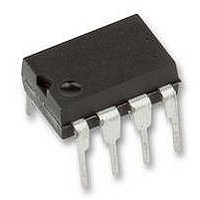LT1025CN#PBF Linear Technology, LT1025CN#PBF Datasheet - Page 4

LT1025CN#PBF
Manufacturer Part Number
LT1025CN#PBF
Description
IC, THERMOCOUPLE COMPENSATOR 0.5°C 8-DIP
Manufacturer
Linear Technology
Datasheet
1.LT1025CNPBF.pdf
(12 pages)
Specifications of LT1025CN#PBF
Ic Output Type
Voltage
Sensing Accuracy Range
0.5°C
Supply Current
80µA
Supply Voltage Range
4V To 36V
Sensor Case Style
DIP
No. Of Pins
8
Ic Generic Number
1025
Temperature Sensing Range
0°C To +70°C
Rohs Compliant
Yes
Lead Free Status / RoHS Status
Lead free / RoHS Compliant
Available stocks
Company
Part Number
Manufacturer
Quantity
Price
APPLICATIO S I FOR ATIO
LT1025
an extender made of matching thermocouple wire can be
used. This shifts the cold junction from the user termina-
tion to the end of the extender so that the LT1025 can be
located remotely from the user termination as shown in
Figure 2.
The four thermocouple outputs on the LT1025 are
60.9 V/ C (E), 51.7 V/ C (J), 40.6 V/ C (K and T), and
6 V/ C (R and S). These particular coefficients are chosen
to match the room temperature (25 C) slope of the
thermocouples. Over wide temperature ranges, however,
the slope of thermocouples changes, yielding a quasi-
parabolic error compared to a constant slope. The LT1025
outputs have a deliberate parabolic “bow” to help
compensate for this effect. The outputs can be mathemati-
cally described as the sum of a linear term equal to room
temperature slope plus a quadratic term proportional to
temperature deviation from 25 C squared . The coefficient
(ß) of the quadratic term is a compromise value chosen to
offer improvement in all the outputs.
The actual ß term which would be required to best
compensate each thermocouple type in the temperature
range of 0 C to 50 C is: E, 6.6 • 10
K, 4.3 • 10
The temperature error specification for the LT1025
10mV/ C output (shown as a graph) assumes a ß of
5.5 •10
if its 10mV/ C output fits the equation V
(10mV)(5.5 • 10
Operating at Negative Temperatures
The LT1025 is designed to operate with a single positive
supply. It therefore cannot deliver proper outputs for
4
V
ß 5.5 • 10
OUT
JUNCTION
–4
= T + ß(T –25 )
“HOT”
. For example, an LT1025 is considered “perfect”
FRONT PANEL
–4
CONNECTOR
; R, 1.9 • 10
– 4
–4
CN
Fe
)(T – 25 C)
U
Figure 2
–3
EXTENDER
U
, S, 1.9 • 10
2
CN
Fe
2
LT1025
.
W
Cu
Cu
“NEW” COLD
JUNCTION
–4
–3
; J, 4.8 • 10
; T, 1 • 10
O
AMPLIFIER
= 10mV(T) +
LT1025 • AG02
U
–3
.
–4
;
temperatures below zero unless an external pull-down
resistor is added to the V
connected to any convenient negative supply. It should be
selected to sink at least 30 A of current. Suggested value
for a – 5V supply is 150k , and for a – 15V supply, 470k .
Smaller resistors must be used if an external load is
connected to the 10mV/ C output. The LT1025 can source
up to 1mA of current, but there is a trade-off with internal
temperature rise.
Internal Temperature Rise
The LT1025 is specified for temperature accuracy assum-
ing no internal temperature rise. At low supply voltages
this rise is usually negligible ( 0.05 C at 5V), but at higher
supply voltages or with external loads or pull-down cur-
rent, internal rise could become significant. This effect can
be calculated from a simple thermal formula, T = (
(V
to ambient, ( 130 C/W), V
I
load current including actual load to ground and any pull-
down current needed to generate negative outputs. A
sample calculation with a 15V supply and 50 A pull-down
current would yield, (130 C/W) (15V) (80 A + 50 A) =
0.32 C. This is a significant rise in some applications. It
can be reduced by lowering supply voltage (a simple fix is
to insert a 10V zener in the V
calibrated and specified after an initial warm-up period of
several minutes.
Driving External Capacitance
The direct thermocouple drive pins on the LT1025 (J, K,
etc.) can be loaded with as much capacitance as desired,
but the 10mV/ C output should not be loaded with more
than 50pF unless external pull-down current is added, or
a compensation network is used.
Thermocouple Effects in Leads
Thermocouple voltages are generated whenever dissimi-
lar materials are joined. This includes the leads of IC
packages, which may be kovar in TO-5 cans, alloy 42 or
copper in dual-in-line packages, and a variety of other
materials in plating finishes and solders. The net effect
of these thermocouples is “zero” if all are at exactly the
Q
is the LT1025 supply current ( 80 A) and I
+
)(I
Q
+ I
L
), where
JA
is thermal resistance from junction
O
+
is the LT1025 supply voltage,
output. This resistor can be
IN
lead) or the system can be
L
is the total
1025fb
JA
)














